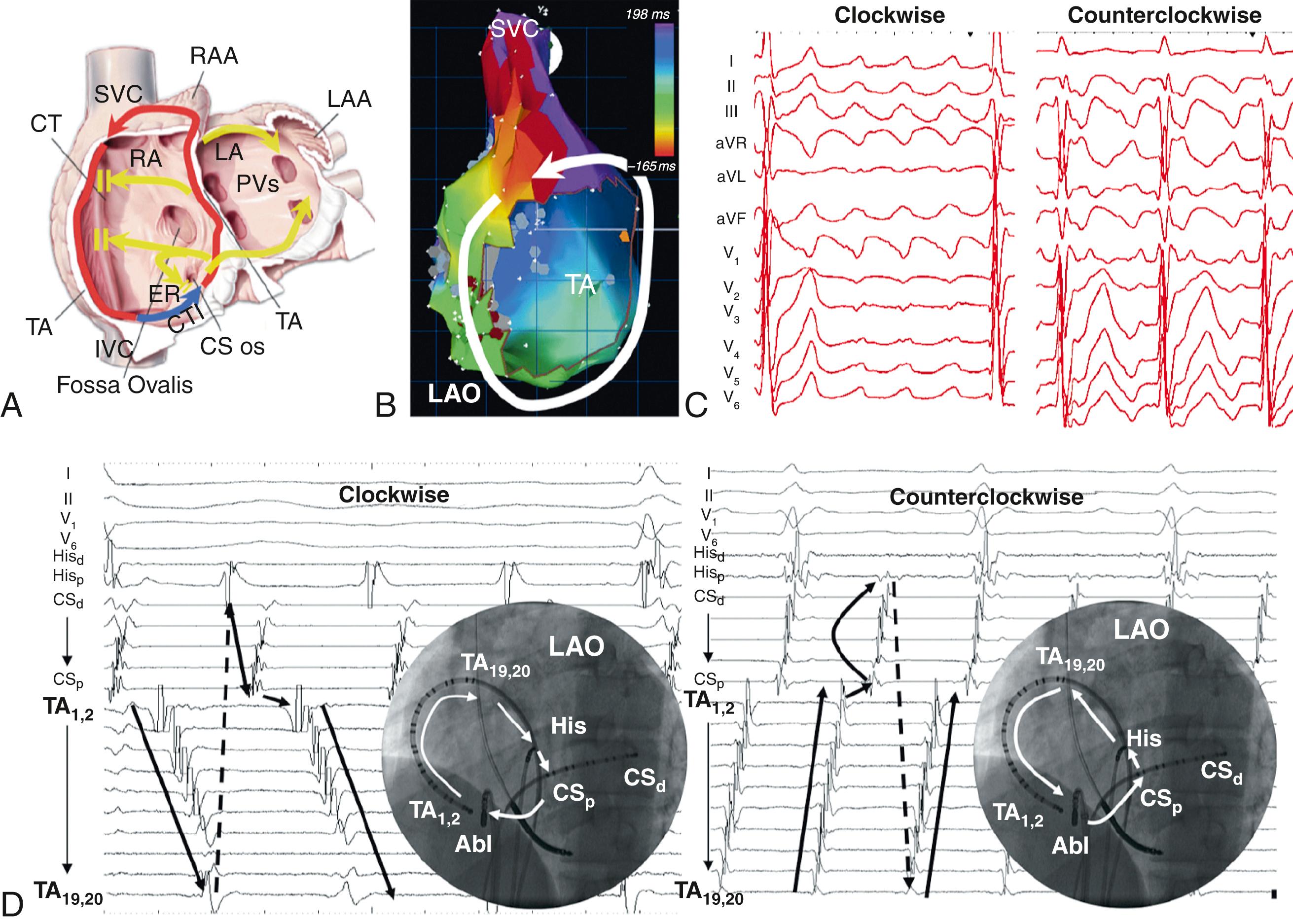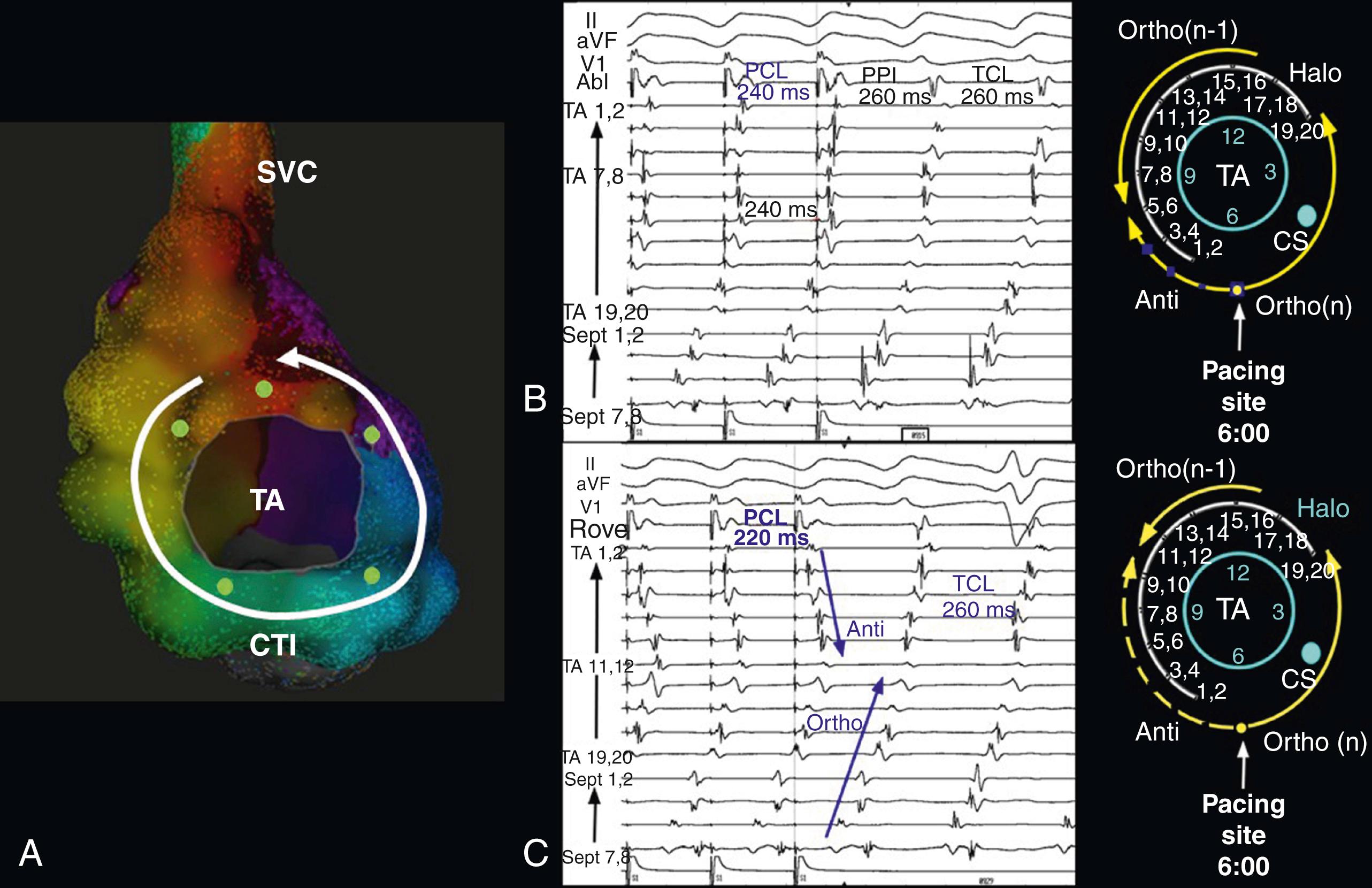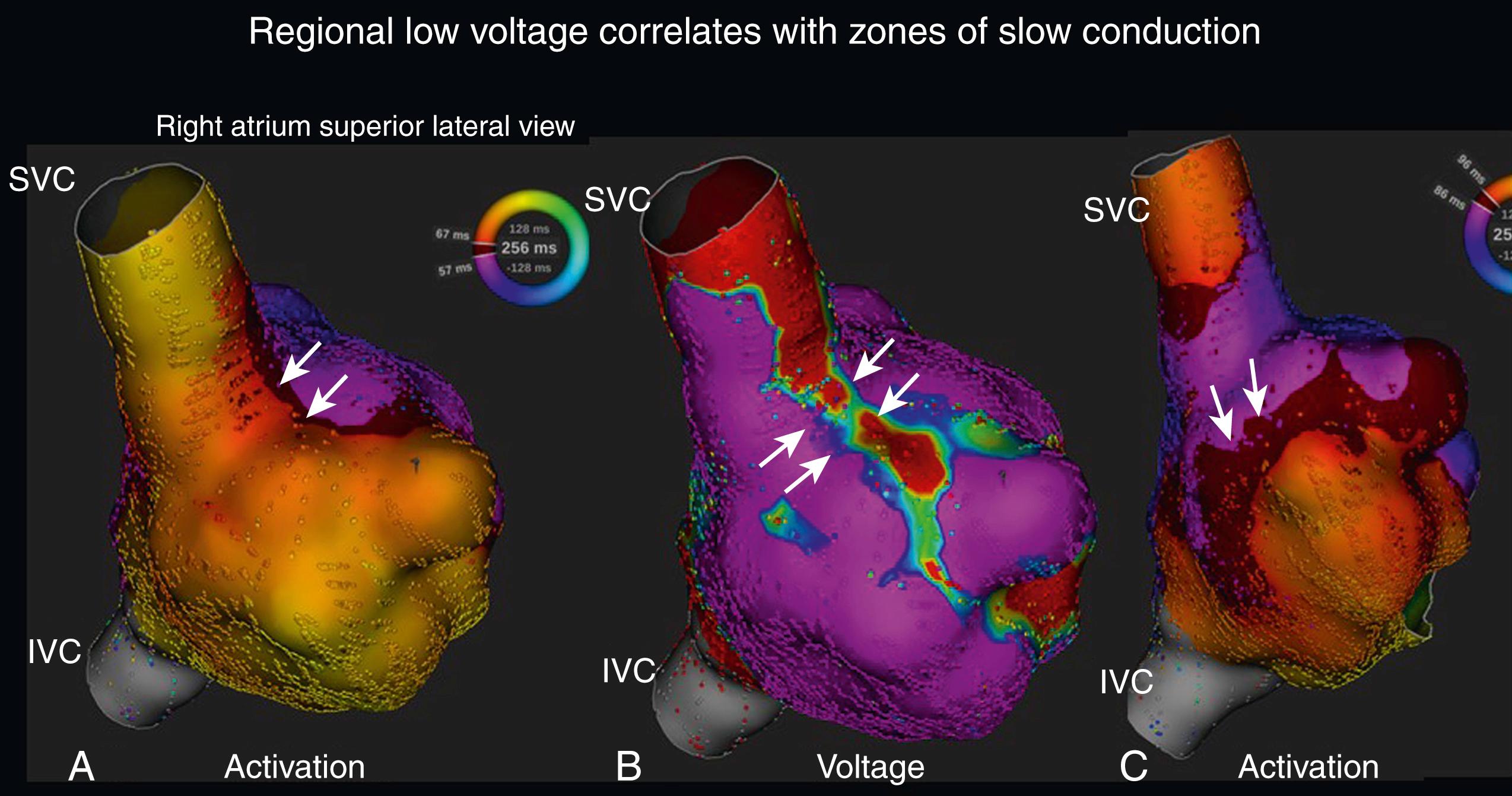Physical Address
304 North Cardinal St.
Dorchester Center, MA 02124
Atrial flutter (AFL) is one of the most common cardiac arrhythmias in humans, afflicting approximately 0.19 million people in the United States in 2005; its prevalence is expected to increase to 0.44 million by 2050 because of the aging population. AFL often occurs in the context of structural heart disease (e.g., valvular, ischemic heart disease, cardiomyopathy) and may manifest during acute disease process (e.g., sepsis, myocardial infarction). This chapter reviews recent advances in our understanding of AFL mechanisms, its heterogeneous nature, and treatment. We define AFL as an arrhythmia with a macroreentrant circuit (>2 cm) distinct from focal atrial tachycardias (or small circuit reentry) with subsequent centrifugal spread.
Reentry as the mechanism of AFL was first suspected in the canine heart. Although AFL was difficult to induce and sustain in the normal atria, a linear lesion between the superior vena cava (SVC) and inferior vena cava (IVC) facilitated AFL inducibility and sustainability. A line of block enabled reentry around an electrically inert obstacle without short circuiting. These fundamental principles can be extrapolated such that the line of block need not be located at the intercaval region and may be functional and anatomical in nature. Thus a right atrial (RA) lesion, as in the case of an atriotomy scar, can form the obstacle around which a wavefront circulates (incisional reentry).
However, the functional extension of a fixed line of block as described in an animal model may result in a circuit similar to typical AFL, where the extended line of block forms a posterior barrier. In the absence of the functional extension of the anatomic line of block, reentry was noted to occur around the lesion alone. These findings explain the mechanism for the coexistence of classical cavotricuspid isthmus (CTI)-dependent AFL and incisional reentrant AFL, and the conversion from one arrhythmia to the other after development of CTI block with catheter ablation.
Animal and human studies of induced and spontaneous AFL have shown that AFL is usually preceded by a transitional period of atrial fibrillation (AF). It appears that AF provides the necessary line of intercaval block for flutter reentry. Absence of the line of block results in AF persistence or termination without transition to AFL, and shortening of the line of block converts AFL to AF. This is clinically evidenced by the conversion of AF to AFL by antiarrhythmic drugs that slow atrial conduction by creating a posterior or intercaval functional line. Because of the dependence of flutter on fibrillation, the two arrhythmias commonly coexist clinically, with documented AF in up to 75% of AFL patients.
Though AF and AFL frequently coexist, one arrhythmia usually dominates. The predominance of AFL may be explained by more advanced RA remodeling with slowed conduction and regional conduction block, particularly in the posterior RA. This distribution of remodeling may facilitate the stabilization of AFL and its persistence as the dominant clinical arrhythmia. When episodes of AFL are remotely studied, atria demonstrate atrial structural changes, conduction abnormalities, and sinus node dysfunction and may explain a predisposition to AFL and the subsequent development of AF.
Clinical data that demonstrate the high rate of incident AF in AFL patients highlight the close pathophysiologic relationship of the two arrhythmias. Some clinical scores have been developed to predict the risk for developing AF after AFL ablation (e.g., HATCH score). AFL patients in whom AF was inducible were also at a higher risk for clinical AF. Among AFL patients, concomitant CTI ablation and pulmonary vein isolation (PVI) decrease the recurrence of AFL. , The elimination of PV triggers prevents the development of AF, which may be viewed as the initiating rhythm for AFL. In a separate study, incident AF was decreased in flutter patients who underwent prophylactic PVI versus CTI ablation alone.
There is emerging evidence of a genetic basis for AFL and AF. The rs2200733 allele (4q25) increases the risk for AFL twofold and implies that the AFL phenotype results from a complex interaction between genetic and clinical factors.
The close relationship of AFL with AF makes the same mechanistic factors relevant for both arrhythmias. It is in this context that lifestyle factors have emerged as important considerations for understanding the mechanism and management of both arrhythmias. Contemporary data have shown that lifestyle factors including obesity, obstructive sleep apnea, alcohol intake, hypertension, and glycemic control are important for the pathophysiology and management of AFL and AF. Thus any management paradigm for AFL must encompass treatment of lifestyle factors in addition to pharmacologic- or catheter-based interventions.
These circuits may be characterized as RA with a broad activation wavefront rotating between the tricuspid annulus (TA) as the anterior barrier and crista terminalis–eustachian ridge/IVC as the posterior barrier in either a counterclockwise or clockwise direction. The CTI provides the narrowest segment of the circuit ( Fig. 78.1A–B) . Although these are critical barriers, significant variations in the leading edge or active region of the reentrant loop have been described. In an entrainment study, Santucci and colleagues demonstrated that approximately one-third of typical AFL cases had an active circuit adjacent to the TA. In other cases, the circuit took an oblique course between the anterior and posterior barriers, with the upper circuit off the annulus and posterior to the RA appendage (RAA) base. Of these, some coursed anterior to the SVC and others behind the SVC (across the crista terminalis). In other cases, bifurcation of the upper circuit was seen around the RAA, SVC, or both. Traditionally, the crista terminalis was considered a region of wavefront slowing in typical AFL. However, recent high-density mapping studies have demonstrated that the most common location of the posterior line of block was the posteromedial right atrium that continued superiorly into the SVC, taking an oblique course to finish on the anterior SVC aspect.

Counterclockwise-typical AFL is the most common form of macroreentrant AFL. The classical inferior lead flutter waves (sawtooth pattern) demonstrate an initial gradual downsloping segment followed by a deeply inverted component with a terminal positive component (of variable amplitude) (see Fig. 78.1C ). Although the flutter wave typically appears inverted in inferior leads, variations in the amplitude of both the negative and positive components can create atypical patterns. In the precordial leads, V 1 classically demonstrates an initial isoelectric component followed by an upright component. With progression across the precordial leads, the initial component becomes inverted and the second component becomes isoelectric such that V 5 and V 6 demonstrate an inverted flutter wave. Lead I is low amplitude/isoelectric and aVL is usually upright (see Fig. 78.1C ). Unusual flutter wave morphologies may be seen with counterclockwise AFL, and a left AFL may mimic the counterclockwise AFL appearance.
Clockwise AFL makes up 10% of cases with its boundaries identical to counterclockwise AFLs but with a reversal of the wavefront activation. Surface electrocardiogram (ECG) is less predictable but retains some characteristic features. Flutter waves in the inferior leads are usually broadly positive, with the upright component preceded by an inverted component of variable amplitude. There is characteristic notching on the upright component, which has a bifid appearance. V 1 is characterized by a broad negative and usually notched deflection with a transition to an upright deflection in V 6 . Lead I is usually upright and aVL is low amplitude negative, giving an overall appearance that is the reverse of counterclockwise AFL (see Fig. 78.1C ).
Notwithstanding typical ECG patterns, the mapping of AFL by activation and entrainment techniques remains critical prior to ablation. Activation sequences demonstrate clockwise or anticlockwise RA activation during flutter, with a multipolar catheter positioned in the coronary sinus (CS) and around the TA and His bundle positions (see Fig. 78.1D ). When patients present in sinus rhythm, atrial pacing can be used to initiate AFL, although there is an inherent risk for inducing AF. Onset typically occurs during burst atrial pacing, leading to unidirectional block within the CTI.
Electrophysiologic testing of typical AFL is primarily aimed at confirming that the circuit is macroreentrant and that the CTI is integral. At a minimum, entrainment should be performed within the CTI to confirm that it is within the circuit (postpacing interval–tachycardia cycle length [PPI-TCL] <20 ms). In atypical AFL, a PPI less than TCL indicates entrainment from within a confined critical isthmus and is caused by virtual electrode upstream and downstream direct capture. We use entrainment pacing with a CL of 10 to 20 ms less than the TCL. Entrainment should be performed with synchronization to the entraining electrode to avoid the initial introduction of a tight-coupled stimulus that may terminate or change the circuit. Where the entraining CL is short, decrement can be introduced into the circuit that produces an erroneous result by prolonging PPI. Entrainment should be performed at multiple sites that are anticipated to lie within (i.e., around the TA) and outside the circuit (mid and distal CS) to confirm the AFL mechanism. Furthermore, only a few extrastimuli are required to entrain the large AFL circuit in the RA. , When entrainment is “in” at two sites more than 2 cm apart, the presence of macroreentry is confirmed ( Fig. 78.2A ). Small circuit reentry is observed when the entire AFL circuit is localized on a single catheter. ,

During transient entrainment of a tachycardia with a pacing CL of 10 to 20 ms shorter than the flutter CL, the wavefront from each pacing impulse propagates in both the orthodromic and antidromic directions. The antidromic wavefront will collide with the preceding orthodromic wavefront as it exits the critical isthmus. Entrainment will result in acceleration of the atrium to the pacing CL with each antidromic wavefront colliding with the orthodromic wavefront of the preceding pacing stimulus (constant fusion). When pacing stops, CL of the orthodromic wavefront of the last pacing stimulus is equal to that of the entrainment, but as it does not encounter a further pacing-induced antidromic wavefront, it is not fused (the last entrained but not fused beat). When the pacing rate is further increased, the collision site between the orthodromic and antidromic wavefronts is shifted farther from the pacing site so that more of the ECG complex appears paced (progressive ECG fusion), and more electrogram (EGM) sites are antidromically captured (progressive EGM fusion). When entrainment is performed in a narrow isthmus, the extent of antidromic capture is limited within the isthmus and fusion will not be evident on surface ECG (concealed entrainment) (see Fig. 78.2B ). When outside a protected isthmus, antidromic atrial capture or penetration is more extensive and therefore manifests on the surface ECG (manifest fusion) (see Fig. 78.2C ).
However, although the presence of concealed entrainment can be an extremely useful tool for mapping ventricular arrhythmias, in practice it is of limited utility for atrial arrhythmias. The flutter wave morphology is of relatively low amplitude and is frequently obscured by an overlap with QRS complexes and T waves, making it difficult or impossible to detect changes in morphology. Distortion of the stimulus artifact may render it difficult to detect subtle degrees of fusion. Thus although entrainment remains one of the cornerstone tools for the evaluation of atrial arrhythmias, the focus is on PPI-TCL to determine which sites are within the circuit.
High-density three-dimensional (3D) electroanatomic mapping (contact or noncontact mapping) is able to delineate the RA circuit during typical AFL with the use of activation maps represented as a continuous progression of colors (see Fig. 78.2A ). A key point in activation mapping using electroanatomic mapping systems in macroreentrant circuits is that early activation is not applicable to any specific point in the circuit as activation is continuous and the origin of activation is always arbitrary with respect to the particular reference chosen for illustration. Activation timing should span the entire CL of a macroreentrant circuit, where “earliest” meets “latest” activation in a continuous circuit (“head meets tail”) is again an arbitrary anatomic point determined by the choice of the zero point.
Using 3D mapping, the activation wavefront in counterclockwise AFL will most typically appear as a broad wavefront that exits the medial CTI, ascends the septum, passes anterior to the SVC, and descends the anterolateral RA to laterally enter the CTI (see Fig. 78.1B ). Passive wavefronts will activate the left atrium (LA) and posterior RA where conduction delay or block will prevent a “short circuiting” of the TA ( Fig. 78.3 ). Recent high-density mapping studies have localized the region of block more posteriorly in the RA than previously anticipated (see Fig. 78.3 ). In addition to entrainment and noncontact mapping, 3D mapping can characterize tissue voltage of the CTI, which may be useful in planning ablation as lower voltage may predict an easier ablation path. Delineation of regions amenable to simple ablation may be facilitated by magnetic resonance imaging (MRI) in the future (see Fig. 78.3 ).

Lower loop reentry is also a CTI-dependent flutter but has a shorter circuit confined to the lower RA, with clockwise or counterclockwise rotation around the IVC. It is created by the presence of a posterior breakthrough at the crista terminalis and often coexists with typical AFL around the TA. The circuit exits the medial CTI, with activation proceeding across the posterior RA. Clockwise variants of lower loop reentry have also been described. The true prevalence of lower loop reentry is uncertain as the ECG morphology may be indistinguishable from typical flutter and termination occurs with CTI ablation. It is therefore possibly more common than diagnosed. Subtle differences between flutter wave morphology and typical flutter are determined by the level of breakthrough at the crista terminalis. Low lateral RA breakthrough will result in attenuation of the late positive deflection of the flutter wave compared with that of counterclockwise typical AFL.
Intraisthmus reentry is a circuit that revolves around the medial CTI and CS ostium; the lateral isthmus is not part of the circuit. Concealed entrainment is demonstrable in the medial CTI or CS ostium but not in the lateral CTI, and other sites around the TA are out of the circuit.
Double-wave reentry is induced when a critically timed atrial extrastimulus is introduced into an AFL circuit with a wide excitable gap resulting in a second excitation wavefront such that two wavefronts simultaneously coexist within the circuit. The phenomenon manifests as acceleration of the flutter CL with identical surface and intracardiac EGM morphology and simultaneous activation of the superior and inferior TA. Generally, this rhythm lasts for only a few beats and can trigger AF.
Principles of pharmacologic treatment are to control ventricular rate during AFL with the use of atrioventricular (AV) nodal–blocking agents (β-blockers or cardiac-selective calcium channel blockers) and/or the maintenance of sinus rhythm with class I or III antiarrhythmic drugs. Class Ic drugs may stabilize the flutter by slowing the rate and increasing the excitable gap, which can result in 1:1 AV conduction. Because of the presence of postreversion atrial stunning (pharmacological or electrical), it is mandatory to follow anticoagulation guidelines for the reversion of AF. Because of the high late incidence of AF after successful flutter ablation coupled with the documented late risk for stroke, it is our practice to make decisions regarding ongoing anticoagulation (with Coumadin or an equivalent) on the basis of the CHADS 2 score. In the absence of supporting data, an alternate approach is to continue to closely monitor for the development of late AF, particularly in patients with stroke risk factors.
Become a Clinical Tree membership for Full access and enjoy Unlimited articles
If you are a member. Log in here